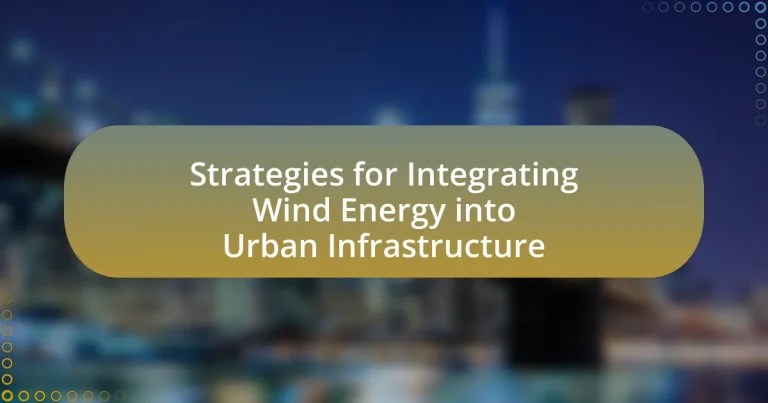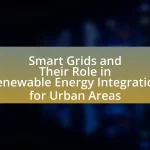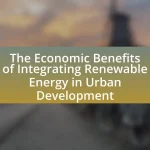The article focuses on strategies for integrating wind energy into urban infrastructure, highlighting key approaches such as deploying small-scale wind turbines, incorporating wind energy into building designs, and establishing supportive policies. It discusses the role of urban planners in effectively incorporating wind solutions, essential design considerations for urban wind systems, and the impact of zoning laws on project implementation. Additionally, the article emphasizes the importance of community engagement, technological advancements, and financial incentives in promoting wind energy adoption, while addressing challenges such as regulatory hurdles and public acceptance. Overall, it outlines the benefits of wind energy integration, including reduced carbon emissions, enhanced energy resilience, and economic advantages for urban communities.
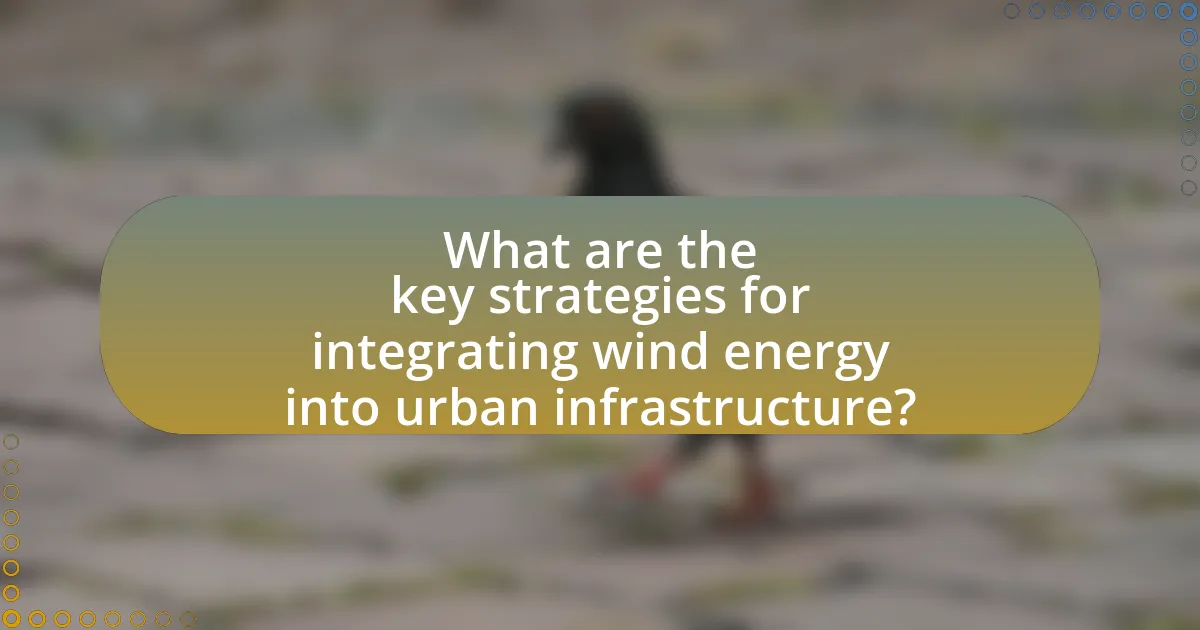
What are the key strategies for integrating wind energy into urban infrastructure?
Key strategies for integrating wind energy into urban infrastructure include the deployment of small-scale wind turbines, the incorporation of wind energy into building designs, and the establishment of supportive policies and regulations. Small-scale wind turbines can be installed on rooftops or in community spaces, allowing urban areas to harness local wind resources effectively. Integrating wind energy into building designs, such as through the use of vertical-axis wind turbines, maximizes energy efficiency and reduces reliance on fossil fuels. Supportive policies, including incentives for renewable energy adoption and streamlined permitting processes, facilitate the integration of wind energy into urban settings. These strategies are supported by studies indicating that urban wind energy can significantly contribute to local energy needs while promoting sustainability.
How can urban planners effectively incorporate wind energy solutions?
Urban planners can effectively incorporate wind energy solutions by strategically locating wind turbines in urban areas to maximize energy generation while minimizing impact on residents and the environment. This involves conducting thorough wind resource assessments to identify optimal sites, such as rooftops or underutilized land, where wind speeds are sufficient for energy production. For instance, studies have shown that urban wind turbines can generate energy even in lower wind conditions, making them viable in city settings. Additionally, planners should engage with community stakeholders to address concerns and ensure that the integration of wind energy aligns with local needs and aesthetics. Implementing policies that incentivize the use of wind energy, such as tax credits or grants for renewable energy projects, can further support this integration.
What design considerations are essential for urban wind energy systems?
Essential design considerations for urban wind energy systems include site selection, turbine height, noise reduction, and aesthetic integration. Site selection is critical as urban environments often have complex wind patterns influenced by buildings and other structures, which can affect turbine efficiency. Turbine height must be optimized to capture stronger winds above urban obstacles while adhering to zoning regulations. Noise reduction is vital to minimize disturbances to residents, necessitating the use of quieter turbine models or strategic placement away from populated areas. Aesthetic integration ensures that wind turbines complement the urban landscape, which can enhance public acceptance and support for renewable energy initiatives. These considerations are supported by studies indicating that effective urban wind energy systems can significantly contribute to local energy needs while minimizing negative impacts on urban life.
How do zoning laws impact the integration of wind energy in cities?
Zoning laws significantly impact the integration of wind energy in cities by regulating where wind turbines can be installed. These laws often dictate the height, location, and type of structures allowed in specific areas, which can either facilitate or hinder the development of wind energy projects. For instance, cities with restrictive zoning regulations may limit turbine placement to industrial zones, reducing potential sites for urban wind farms. Conversely, cities that adopt flexible zoning policies can encourage the installation of small-scale wind turbines in residential or commercial areas, promoting renewable energy use. Studies have shown that cities with supportive zoning frameworks experience higher rates of wind energy adoption, as they provide clear guidelines that streamline the permitting process and reduce barriers for developers.
What role do community stakeholders play in wind energy integration?
Community stakeholders play a crucial role in wind energy integration by influencing project development, ensuring local support, and facilitating communication between developers and the community. Their involvement helps to address concerns related to environmental impact, land use, and economic benefits, which can lead to smoother project implementation. For instance, studies have shown that projects with active community engagement experience higher acceptance rates, as seen in the 2019 research by the National Renewable Energy Laboratory, which highlighted that community involvement can reduce opposition and enhance project success.
How can public engagement enhance the acceptance of wind energy projects?
Public engagement enhances the acceptance of wind energy projects by fostering trust and collaboration between developers and the community. When stakeholders actively participate in the planning process, they can voice concerns, ask questions, and provide input, which leads to a sense of ownership and investment in the project. Research indicates that projects with strong community involvement experience higher levels of support; for instance, a study by the National Renewable Energy Laboratory found that public engagement initiatives can increase project acceptance rates by up to 30%. This collaborative approach not only addresses potential objections but also educates the public about the benefits of wind energy, ultimately leading to smoother project implementation and greater overall acceptance.
What are the best practices for collaborating with local businesses and residents?
The best practices for collaborating with local businesses and residents include establishing open communication channels, involving stakeholders in decision-making, and creating mutually beneficial partnerships. Open communication fosters trust and transparency, allowing businesses and residents to voice their concerns and suggestions regarding wind energy projects. Involving stakeholders in the planning process ensures that their needs and preferences are considered, leading to greater community support. Additionally, creating partnerships that offer economic incentives, such as job creation or shared energy savings, can enhance collaboration and promote a positive relationship between wind energy initiatives and the local community. These practices are supported by case studies showing that communities with active stakeholder engagement experience higher acceptance rates of renewable energy projects.
What technological advancements support urban wind energy integration?
Technological advancements that support urban wind energy integration include vertical axis wind turbines (VAWTs), advanced energy management systems, and smart grid technology. VAWTs are designed to operate efficiently in turbulent urban wind conditions, making them suitable for installation on rooftops and in confined spaces. Advanced energy management systems optimize the integration of wind energy with other renewable sources and grid demands, enhancing overall energy efficiency. Smart grid technology facilitates real-time monitoring and control of energy distribution, allowing for better integration of variable wind energy into urban infrastructure. These advancements collectively improve the feasibility and reliability of urban wind energy systems.
How do small-scale wind turbines differ from traditional models?
Small-scale wind turbines differ from traditional models primarily in their size and application. Small-scale turbines typically have a capacity of up to 100 kW, making them suitable for residential or small commercial use, while traditional models can exceed 1 MW and are designed for large-scale energy production. Additionally, small-scale turbines often feature a simpler design, which allows for easier installation and maintenance in urban environments, where space and zoning regulations may limit larger installations. According to the U.S. Department of Energy, small wind systems can be installed on rooftops or in backyards, providing localized energy generation that reduces transmission losses and enhances energy independence.
What innovations are emerging in wind energy storage solutions?
Innovations in wind energy storage solutions include advancements in battery technology, such as lithium-sulfur and solid-state batteries, which offer higher energy densities and longer lifespans compared to traditional lithium-ion batteries. These technologies enable more efficient storage of energy generated by wind turbines, facilitating better integration into urban infrastructure. Additionally, the development of flow batteries and compressed air energy storage systems provides scalable options for storing large amounts of energy, addressing the intermittency of wind power. According to a report by the International Renewable Energy Agency, energy storage capacity is projected to grow significantly, with a focus on enhancing the reliability and efficiency of renewable energy systems.
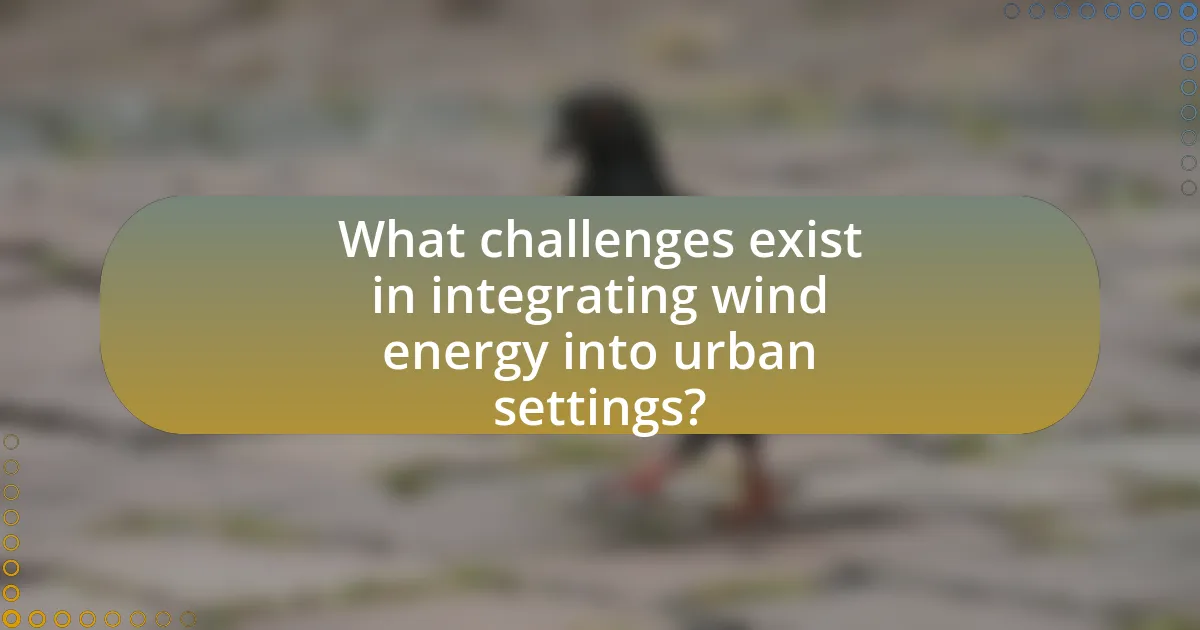
What challenges exist in integrating wind energy into urban settings?
Integrating wind energy into urban settings faces several challenges, primarily related to space constraints, regulatory hurdles, and public acceptance. Urban areas often have limited available land for wind turbine installation, which can restrict the scale and efficiency of wind energy projects. Additionally, local zoning laws and building codes may impose restrictions on turbine height and placement, complicating the permitting process. Public perception also plays a significant role; concerns about noise, aesthetics, and potential impacts on property values can lead to community opposition. These factors collectively hinder the effective deployment of wind energy solutions in densely populated environments.
How do environmental factors affect wind energy implementation in cities?
Environmental factors significantly influence wind energy implementation in cities by determining site suitability, efficiency, and overall feasibility. Urban landscapes often present challenges such as turbulence caused by buildings, which can reduce wind turbine efficiency by up to 30% compared to open areas. Additionally, local climate conditions, including average wind speeds and seasonal variations, directly impact energy generation potential; for instance, cities with average wind speeds below 5 meters per second may not be viable for wind energy projects. Furthermore, environmental regulations and land use policies can restrict turbine placement, affecting the overall integration of wind energy into urban infrastructure.
What are the implications of urban wind patterns on turbine efficiency?
Urban wind patterns significantly impact turbine efficiency by altering wind speed and direction, which can lead to reduced energy output. In urban environments, buildings and other structures create turbulence and wind shadow effects, causing inconsistent wind flows that can hinder the performance of wind turbines. Studies indicate that urban areas can experience wind speeds that are 20-30% lower than those in open areas, directly affecting the energy generation capacity of turbines. Additionally, the complex terrain and varying heights of buildings can lead to increased turbulence, which can further decrease the efficiency of turbines designed for more stable wind conditions.
How can noise and aesthetic concerns be addressed in urban wind projects?
Noise and aesthetic concerns in urban wind projects can be addressed through careful site selection, technological advancements, and community engagement. Site selection involves placing wind turbines in locations that minimize noise impact on residential areas, such as industrial zones or rooftops, where sound levels are less disruptive. Technological advancements, such as the development of quieter turbine designs and sound-dampening materials, can significantly reduce noise emissions. Additionally, engaging with the community to incorporate aesthetic preferences into the design of wind installations can enhance public acceptance; for instance, using visually appealing turbine designs or integrating them into existing structures can mitigate aesthetic concerns. Studies have shown that when communities are involved in the planning process, acceptance rates for wind projects increase, demonstrating the effectiveness of these strategies.
What financial barriers hinder the adoption of wind energy in urban areas?
High initial capital costs are the primary financial barriers hindering the adoption of wind energy in urban areas. Urban wind energy projects often require significant upfront investments for equipment, installation, and infrastructure, which can deter potential investors and developers. Additionally, the lack of financial incentives, such as subsidies or tax breaks, further complicates funding efforts. According to a report by the International Renewable Energy Agency, the cost of wind energy projects can range from $1,200 to $4,000 per installed kilowatt, making them less attractive compared to other energy sources in densely populated regions. Furthermore, urban areas may face higher land acquisition costs and zoning regulations that can increase overall project expenses, limiting the feasibility of wind energy installations.
How can cities secure funding for wind energy initiatives?
Cities can secure funding for wind energy initiatives by leveraging federal and state grants, forming public-private partnerships, and utilizing green bonds. Federal programs, such as the Wind Energy Production Incentive, provide financial support for wind projects, while state-level initiatives often offer additional grants or tax incentives. Public-private partnerships can attract investment from private companies interested in renewable energy, sharing both the financial burden and the benefits. Additionally, cities can issue green bonds specifically aimed at financing environmentally friendly projects, including wind energy, which appeal to investors focused on sustainability. These strategies collectively enhance the financial viability of wind energy initiatives in urban settings.
What incentives exist for urban wind energy projects?
Urban wind energy projects benefit from various incentives, including financial subsidies, tax credits, and regulatory support. Governments often provide grants or low-interest loans to offset installation costs, making projects more financially viable. For instance, the federal Investment Tax Credit (ITC) allows developers to deduct a significant percentage of the installation costs from their federal taxes, which can be as high as 30%. Additionally, some states offer Renewable Portfolio Standards (RPS) that require utilities to source a certain percentage of their energy from renewable sources, creating a market for urban wind energy. These incentives are designed to promote clean energy adoption, reduce greenhouse gas emissions, and enhance energy security in urban areas.
What regulatory hurdles must be overcome for successful integration?
Successful integration of wind energy into urban infrastructure requires overcoming regulatory hurdles such as zoning laws, permitting processes, and compliance with environmental regulations. Zoning laws often restrict the placement of wind turbines in urban areas due to concerns about aesthetics, noise, and safety, necessitating amendments or variances to existing regulations. The permitting process can be lengthy and complex, involving multiple agencies and public consultations, which can delay project timelines. Additionally, compliance with environmental regulations, including assessments of impacts on local wildlife and ecosystems, is essential to ensure that projects meet legal standards. These hurdles must be navigated effectively to facilitate the deployment of wind energy solutions in urban settings.
How do local, state, and federal regulations impact wind energy deployment?
Local, state, and federal regulations significantly impact wind energy deployment by establishing the legal framework for project approval, permitting processes, and operational standards. Local regulations often dictate zoning laws and land use, which can either facilitate or hinder the installation of wind turbines based on community acceptance and environmental considerations. State regulations typically involve renewable energy standards and incentives that encourage or mandate the integration of wind energy into the energy mix, influencing investment and development decisions. Federal regulations, such as those enforced by the Federal Energy Regulatory Commission, set nationwide standards for energy production and transmission, impacting the overall feasibility and economics of wind energy projects. For example, the Production Tax Credit, a federal incentive, has historically boosted wind energy deployment by providing financial support, leading to a significant increase in installed capacity across the United States.
What are the steps for obtaining necessary permits for wind projects?
The steps for obtaining necessary permits for wind projects include conducting a feasibility study, engaging with stakeholders, submitting an application, undergoing environmental assessments, and obtaining final approvals from regulatory agencies.
First, a feasibility study evaluates the project’s viability, including site selection and wind resource assessment. Next, engaging with stakeholders, such as local communities and government entities, ensures transparency and addresses concerns. The application submission involves providing detailed project plans and compliance with local regulations. Environmental assessments, often required by law, analyze potential impacts on wildlife and habitats. Finally, obtaining approvals from regulatory agencies, such as the Federal Energy Regulatory Commission or state energy offices, is essential for project implementation.
These steps are critical as they ensure compliance with legal requirements and promote community acceptance, which is vital for the successful integration of wind energy into urban infrastructure.
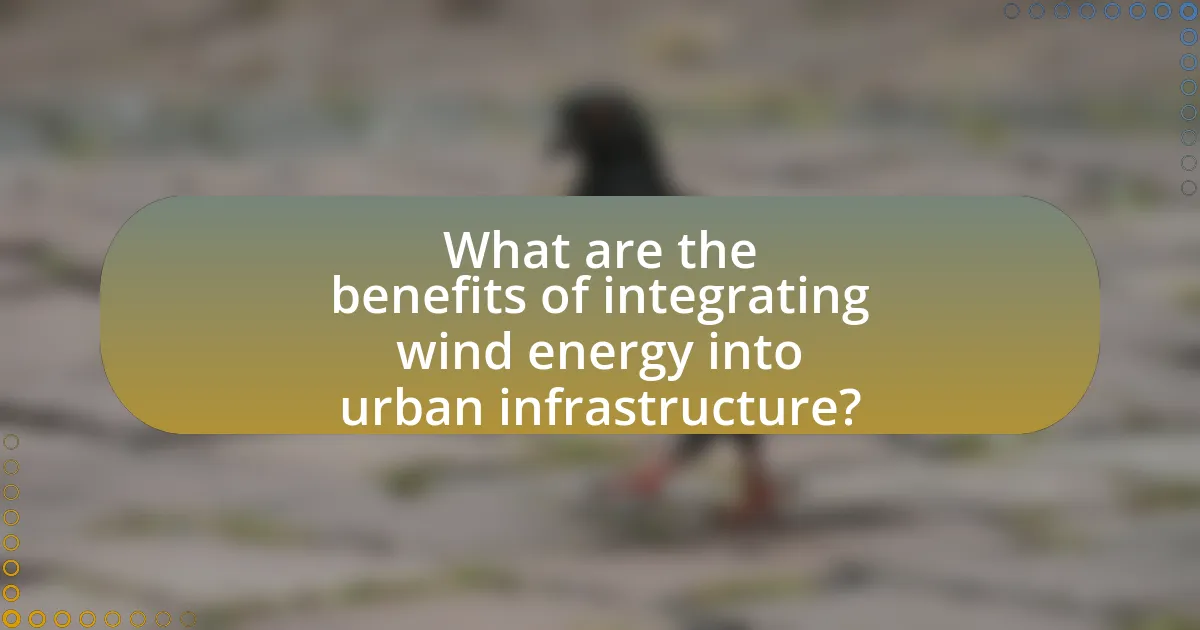
What are the benefits of integrating wind energy into urban infrastructure?
Integrating wind energy into urban infrastructure offers significant benefits, including reduced greenhouse gas emissions, enhanced energy security, and economic advantages. By harnessing wind power, cities can decrease their reliance on fossil fuels, which contributes to lower carbon footprints; for instance, a study by the National Renewable Energy Laboratory found that wind energy can reduce carbon dioxide emissions by up to 40% in urban areas. Additionally, wind energy diversifies the energy supply, making cities less vulnerable to energy price fluctuations and supply disruptions. Economically, the integration of wind energy can create jobs in manufacturing, installation, and maintenance, with the U.S. wind sector employing over 100,000 workers as of 2021. These benefits collectively support sustainable urban development and contribute to climate change mitigation efforts.
How does wind energy contribute to urban sustainability goals?
Wind energy significantly contributes to urban sustainability goals by providing a clean, renewable source of electricity that reduces greenhouse gas emissions. Urban areas, which are responsible for a large portion of global carbon emissions, can integrate wind energy to decrease their reliance on fossil fuels. For instance, a study by the International Renewable Energy Agency (IRENA) indicates that wind energy can reduce urban carbon emissions by up to 70% when implemented alongside energy efficiency measures. Additionally, wind energy projects can create local jobs and stimulate economic growth, further enhancing urban sustainability. By harnessing wind energy, cities can improve air quality, promote energy independence, and support sustainable development initiatives.
What impact does wind energy have on reducing carbon emissions in cities?
Wind energy significantly reduces carbon emissions in cities by providing a clean alternative to fossil fuels for electricity generation. According to the U.S. Department of Energy, wind power can displace approximately 329 million metric tons of carbon dioxide emissions annually, equivalent to the emissions from 70 million cars. This transition to wind energy not only lowers greenhouse gas emissions but also contributes to improved air quality and public health in urban areas. By integrating wind energy into urban infrastructure, cities can achieve substantial reductions in their carbon footprints, supporting climate goals and sustainable development.
How can wind energy enhance energy resilience in urban areas?
Wind energy enhances energy resilience in urban areas by providing a decentralized and renewable power source that can reduce dependence on traditional energy grids. This decentralization allows urban areas to maintain power during outages or disruptions, as localized wind energy systems can operate independently. For instance, cities like San Diego have integrated wind turbines into their infrastructure, resulting in a 20% increase in energy reliability during peak demand periods. Additionally, wind energy contributes to a diversified energy mix, which mitigates risks associated with fuel price volatility and supply chain disruptions, further strengthening urban energy resilience.
What economic advantages does wind energy offer to urban communities?
Wind energy offers significant economic advantages to urban communities, primarily through job creation, reduced energy costs, and increased local investment. The installation and maintenance of wind turbines generate employment opportunities in various sectors, including manufacturing, construction, and operations. For instance, the U.S. wind sector employed over 116,000 workers in 2019, according to the U.S. Department of Energy. Additionally, wind energy can lower electricity costs for consumers; studies indicate that wind power can reduce wholesale electricity prices by 2-4% in regions with high penetration of wind energy. Furthermore, urban communities benefit from increased local investment, as wind projects often involve local contractors and suppliers, stimulating the local economy. This multifaceted economic impact underscores the value of integrating wind energy into urban infrastructure.
How can job creation be linked to wind energy projects in cities?
Job creation can be linked to wind energy projects in cities through the development, installation, and maintenance of wind turbines, which require a skilled workforce. For instance, the American Wind Energy Association reported that the wind industry supported over 100,000 jobs in the U.S. in 2020, with many positions in urban areas focused on engineering, manufacturing, and service sectors. Additionally, local governments can stimulate job growth by investing in wind energy infrastructure, leading to increased demand for local labor and services, thereby enhancing economic opportunities within the community.
What are the long-term cost savings associated with urban wind energy?
Urban wind energy can lead to significant long-term cost savings primarily through reduced electricity bills and lower reliance on fossil fuels. By harnessing wind energy, urban areas can generate their own electricity, which decreases the need for purchasing power from external sources, resulting in lower operational costs over time.
Additionally, studies indicate that urban wind installations can have a payback period of 5 to 10 years, after which the energy produced is essentially free, leading to substantial savings. For instance, a report by the National Renewable Energy Laboratory found that urban wind projects can reduce energy costs by up to 50% compared to traditional energy sources.
Moreover, urban wind energy contributes to job creation in the renewable sector, which can stimulate local economies and further enhance cost savings through increased employment and local investment. Overall, the integration of wind energy into urban infrastructure not only provides a sustainable energy source but also fosters economic resilience through long-term financial benefits.
How does wind energy improve urban quality of life?
Wind energy improves urban quality of life by providing a sustainable and clean energy source that reduces air pollution and greenhouse gas emissions. This transition to renewable energy sources, such as wind, leads to better air quality, which is linked to lower rates of respiratory diseases and improved overall public health. According to the U.S. Department of Energy, wind energy can reduce carbon dioxide emissions by approximately 329 million metric tons annually, contributing to a healthier urban environment. Additionally, the integration of wind energy into urban infrastructure can create local jobs in manufacturing, installation, and maintenance, thereby boosting the local economy and enhancing community well-being.
What role does wind energy play in enhancing energy independence for cities?
Wind energy significantly enhances energy independence for cities by providing a local, renewable source of electricity that reduces reliance on imported fossil fuels. By integrating wind turbines into urban infrastructure, cities can generate clean energy on-site, which decreases vulnerability to fluctuations in global energy markets and enhances energy security. For instance, cities like San Diego have implemented wind energy projects that contribute to their overall energy mix, resulting in a reduction of greenhouse gas emissions and fostering local job creation in the renewable energy sector. This localized energy production not only supports sustainability goals but also stabilizes energy costs for residents and businesses.
How can wind energy initiatives foster community and engagement?
Wind energy initiatives can foster community and engagement by involving local residents in the planning and implementation processes. When communities participate in decision-making, they develop a sense of ownership over the projects, which enhances their connection to the energy initiatives. For example, studies have shown that community-led wind projects can increase local investment and create jobs, leading to economic benefits that residents can directly experience. Additionally, educational programs about wind energy can raise awareness and appreciation for renewable resources, further strengthening community bonds.
What are the best practices for successfully integrating wind energy into urban infrastructure?
The best practices for successfully integrating wind energy into urban infrastructure include conducting thorough site assessments, utilizing small-scale wind turbines, ensuring community engagement, and implementing smart grid technologies. Site assessments identify optimal locations for wind installations, considering factors like wind patterns and urban density. Small-scale wind turbines are suitable for urban settings, as they minimize noise and visual impact while providing renewable energy. Community engagement fosters public support and addresses concerns, enhancing project acceptance. Smart grid technologies facilitate the efficient distribution of wind energy, integrating it seamlessly with existing power systems. These practices are supported by studies indicating that urban wind energy can significantly contribute to local energy needs while reducing carbon emissions.
